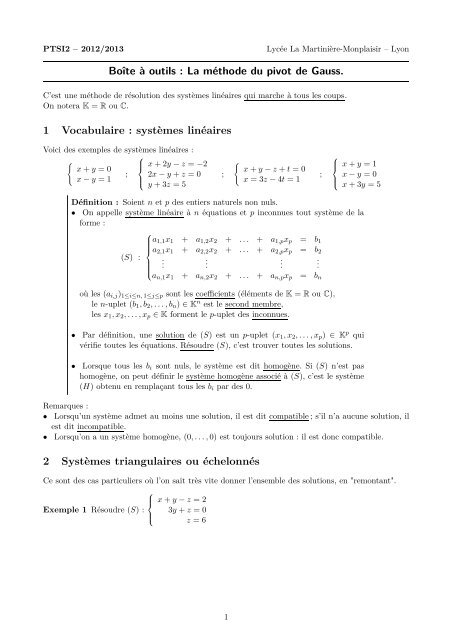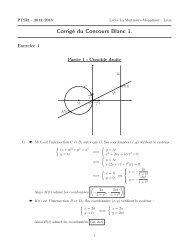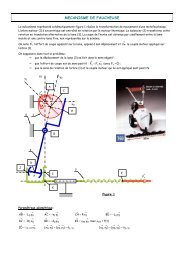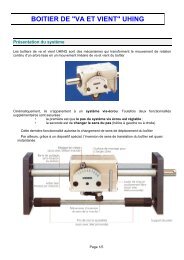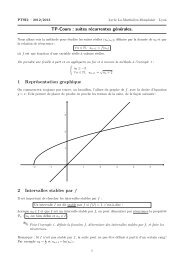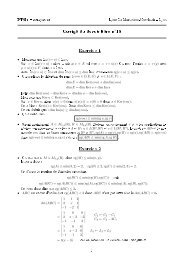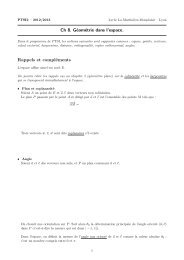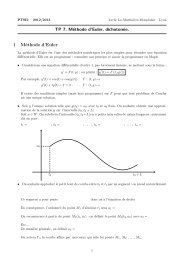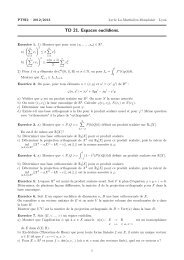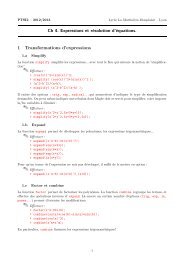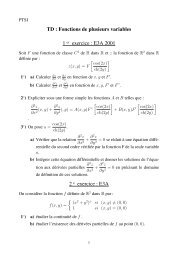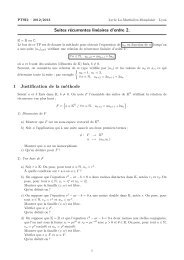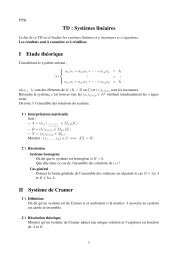Boîte à outils : La méthode du pivot de Gauss. 1 Vocabulaire ...
Boîte à outils : La méthode du pivot de Gauss. 1 Vocabulaire ...
Boîte à outils : La méthode du pivot de Gauss. 1 Vocabulaire ...
You also want an ePaper? Increase the reach of your titles
YUMPU automatically turns print PDFs into web optimized ePapers that Google loves.
PTSI2 – 2012/2013<br />
Lycée <strong>La</strong> Martinière-Monplaisir – Lyon<br />
Boîte à <strong>outils</strong> : <strong>La</strong> métho<strong>de</strong> <strong>du</strong> <strong>pivot</strong> <strong>de</strong> <strong>Gauss</strong>.<br />
C’est une métho<strong>de</strong> <strong>de</strong> résolution <strong>de</strong>s systèmes linéaires qui marche à tous les coups.<br />
On notera K = R ou C.<br />
1 <strong>Vocabulaire</strong> : systèmes linéaires<br />
Voici <strong>de</strong>s exemples <strong>de</strong> systèmes linéaires :<br />
⎧<br />
⎪⎨<br />
{<br />
x + y = 0<br />
x − y = 1<br />
;<br />
⎪⎩<br />
x + 2y − z = −2<br />
2x − y + z = 0<br />
y + 3z = 5<br />
;<br />
{<br />
x + y − z + t = 0<br />
x = 3z − 4t = 1<br />
;<br />
⎧<br />
⎪⎨<br />
⎪⎩<br />
x + y = 1<br />
x − y = 0<br />
x + 3y = 5<br />
Définition : Soient n et p <strong>de</strong>s entiers naturels non nuls.<br />
• On appelle système linéaire à n équations et p inconnues tout système <strong>de</strong> la<br />
forme :<br />
⎧<br />
a 1,1 x 1 + a 1,2 x 2 + . . . + a 1,p x p = b 1<br />
⎪⎨ a 2,1 x 1 + a 2,2 x 2 + . . . + a 2,p x p = b 2<br />
(S) :<br />
.<br />
.<br />
.<br />
.<br />
⎪⎩<br />
a n,1 x 1 + a n,2 x 2 + . . . + a n,p x p = b n<br />
où les (a i,j ) 1≤i≤n, 1≤j≤p sont les coefficients (éléments <strong>de</strong> K = R ou C),<br />
le n-uplet (b 1 , b 2 , . . . , b n ) ∈ K n est le second membre,<br />
les x 1 , x 2 , . . . , x p ∈ K forment le p-uplet <strong>de</strong>s inconnues.<br />
• Par définition, une solution <strong>de</strong> (S) est un p-uplet (x 1 , x 2 , . . . , x p ) ∈ K p qui<br />
vérifie toutes les équations. Résoudre (S), c’est trouver toutes les solutions.<br />
• Lorsque tous les b i sont nuls, le système est dit homogène. Si (S) n’est pas<br />
homogène, on peut définir le système homogène associé à (S), c’est le système<br />
(H) obtenu en remplaçant tous les b i par <strong>de</strong>s 0.<br />
Remarques :<br />
• Lorsqu’un système admet au moins une solution, il est dit compatible ; s’il n’a aucune solution, il<br />
est dit incompatible.<br />
• Lorsqu’on a un système homogène, (0, . . . , 0) est toujours solution : il est donc compatible.<br />
2 Systèmes triangulaires ou échelonnés<br />
Ce sont <strong>de</strong>s cas particuliers où l’on sait très vite donner l’ensemble <strong>de</strong>s solutions, en "remontant".<br />
⎧<br />
⎪⎨<br />
Exemple 1 Résoudre (S) :<br />
⎪⎩<br />
x + y − z = 2<br />
3y + z = 0<br />
z = 6<br />
1
Exemple 2 Résoudre (S) :<br />
{<br />
x − y + 3z = 2<br />
y − 2z = 5<br />
{<br />
x + y + z + t = 0<br />
Exemple 3 Résoudre (S) :<br />
y − z = i<br />
2
Comment se ramener à un système triangulaire ou échelonné ?<br />
3 Opérations élémentaires sur les lignes<br />
Ce sont les 3 seules opérations autorisées sur les systèmes, car elles seules permettent <strong>de</strong> gar<strong>de</strong>r un<br />
système équivalent au système <strong>de</strong> départ.<br />
En notant L i la i-ème ligne/équation <strong>du</strong> système :<br />
• Multiplication <strong>de</strong> L i par un α ∈ K non nul :<br />
L i ← αL i<br />
• Échange <strong>de</strong> L i et L j :<br />
L i ↔ L j<br />
• Ajout à L i <strong>de</strong> la ligne L j multipliée par un β ∈ K (avec i ≠ j) :<br />
L i ← L i + βL j<br />
L<br />
A priori il faut les faire une à la fois : par exemple si on écrit 1 ← L 1 + L 3<br />
, on ne sais pas bien<br />
L 2 ← L 2 − 3L 1<br />
quelle ligne L 1 on utilise pour modifier L 2 : la nouvelle ou l’ancienne ? Il faut mettre <strong>de</strong>ux étapes car<br />
cela peut mener à un système faux.<br />
Par contre, on peut faire L 2 ← L 2 + L 1<br />
L 3 ← L 3 − 3L 1<br />
4 Métho<strong>de</strong> <strong>du</strong> <strong>pivot</strong> <strong>de</strong> <strong>Gauss</strong><br />
par exemple, car il n’y a pas d’ambiguïté.<br />
Elle dit quelles opérations élémentaires effectuer pour obtenir à coup sûr un système triangulaire ou<br />
échelonné !<br />
blablablablablablaMétho<strong>de</strong>blablablablablabla<br />
On suppose a 1,1 ≠ 0 : c’est notre premier "<strong>pivot</strong>".<br />
Si ce n’est pas le cas, on échange L 1 avec une ligne<br />
dont le 1er coefficient est non nul.<br />
• Étape 1 : Pour chaque ligne i ≥ 2, on fait<br />
"disparaître" la première inconnue en faisant<br />
L i ← L i − a i,1<br />
L 1 .<br />
a 1,1<br />
On obtient :<br />
blablablablablablaExempleblablablablablabla<br />
⎧<br />
⎪⎨ 2x + 2y + z = 1<br />
(S) : x + 2y − z = 1<br />
⎪⎩ 2x + y + 2z = −1<br />
⎧<br />
a 1,1 x 1 + a 1,2 x 2 + . . . + a 1,p x p = b 1<br />
⎪⎨ a 2,1 x 1 + a 2,2 x 2 + . . . + a 2,p x p = b 2<br />
.<br />
.<br />
.<br />
.<br />
⎪⎩<br />
a n,1 x 1 + a n,2 x 2 + . . . + a n,p x p = b n<br />
• Étape 2 : On fait la même chose avec le "soussystème"<br />
où il n’y a plus <strong>de</strong> x 1 ...<br />
etc jusqu’à obtenir un système triangulaire ou<br />
échelonné.<br />
3
Exercice 1. Résoudre les systèmes suivants :<br />
(S 1 ) :<br />
⎧<br />
⎪⎨<br />
⎪⎩<br />
y + z = 1<br />
x + z = 2<br />
x + y = 3<br />
; (S 2 ) :<br />
⎧<br />
⎪⎨<br />
⎪⎩<br />
2x + y + 2z = 0<br />
x + y − z = 1<br />
3x + 2y + z = 1<br />
; (S 3 ) :<br />
⎧<br />
⎪⎨<br />
⎪⎩<br />
x + y + 3z + t = −2<br />
x + 2y + z + 2t = −1<br />
2x + y − z − t = 8<br />
−x + 2y − z + 4t = −7<br />
Exercice 2. Résoudre les systèmes suivants, selon les paramètres :<br />
⎧<br />
x − y + 2z + t = m<br />
⎪⎨<br />
−2x + 3y + z − 4t = m + 1<br />
(S 1 ) :<br />
, où m est un paramètre réel ;<br />
−3x + 5y + 5z − 2t = m + 2<br />
⎪⎩<br />
−x + 2y − 4z − 38t = 1<br />
⎧<br />
⎪⎨ mx + y + z = 1<br />
(S 2 ) : x + y + (2m − 1)z = 1 , où m est un paramètre réel ;<br />
⎪⎩ x + my + z = 3(m + 1)<br />
(S 3 ) :<br />
(S 4 ) :<br />
⎧<br />
⎪⎨<br />
⎪⎩<br />
⎧<br />
⎪⎨<br />
⎪⎩<br />
2x + y − z = 2<br />
x − y + z = 4<br />
3x + 3y − z = 4a<br />
(2 − a)x + 2y − 2z = −2b<br />
(1 − λ)x + y − 2z = 0<br />
−x + (2 − λ)y − z = 0<br />
−x + y − λz = 0<br />
, où a et b sont <strong>de</strong>s paramètres réels ;<br />
, où λ est un paramètre réel.<br />
4


